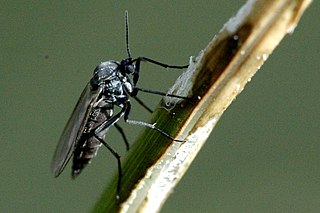
Psychodidae, also called drain flies, sink flies, filter flies, sewer flies, or sewer gnats, is a family of true flies. Some genera have short, hairy bodies and wings, giving them a "furry" moth-like appearance, hence one of their common names, moth flies. Members of the sub-family Phlebotominae, which are hematophagous, may be called sand flies in some countries, although this term is also used for other unrelated flies.

Fungus gnats are small, dark, short-lived gnats, of the families Sciaridae, Diadocidiidae, Ditomyiidae, Keroplatidae, Bolitophilidae, and Mycetophilidae ; they comprise six of the seven families placed in the superfamily Sciaroidea.

Mycetophilidae is a family of small flies, forming the bulk of those species known as fungus gnats. About 3000 described species are placed in 150 genera, but the true number of species is undoubtedly much higher. They are generally found in the damp habitats favoured by their host fungi and sometimes form dense swarms.

Keroplatidae is a family of small flies known as fungus gnats. About 950 species are described, but the true number of species is undoubtedly much higher. The long-beaked fungus gnats, formerly placed in a separate family Lygistorrhinidae, have been placed into Keroplatidae as subfamily Lygistorrhininae. They are generally forest dwellers found in the damp habitats favoured by their host fungi. They can also often be found in caves. Larvae both feed on fungi and are predatory - they can spin webs by secreting acid fluids, which they use to kill smaller invertebrates and capture spores. Some of the predatory larvae cannibalize pupa of their own species. The family notably includes three genera containing bioluminescent larvae.

Macrocera parva is a Palearctic species of 'fungus gnat' in the family Keroplatidae.Larvae of species in this genus have been reared from a range of situations including clumps of turf, rotting wood and cave walls and are thought to be predaceous.

Gnoristinae is a subfamily of fungus gnats in the family Mycetophilidae. There are about 6 genera and at least 4 described species in Gnoristinae.

Psyllipsocidae is a family of cave barklice in the order Psocodea. There are about 7 genera and more than 70 described species in Psyllipsocidae.
Keroplatus is a genus of predatory fungus gnats in the family Keroplatidae. Several species are known to be bioluminescent.

Proctotrupidae is a family of parasitic wasps in the superfamily Proctotrupoidea. There are about 400 species in more than 30 genera in Proctotrupidae, found throughout most of the world.

Lygistorrhininae, commonly called long-beaked fungus gnats is a subfamily of flies in the Diptera family Keroplatidae. The groups was long treated as a separate family, but molecular phylogenetic analysis has shown it to belong to Keroplatidae. There are about 7 genera and at least 30 described species in Lygistorrhininae.

Mycetophilinae is a subfamily of fungus gnats in the family Mycetophilidae. There are more than 30 genera and 2,000 described species in Mycetophilinae. There are two tribes, Exechiini and Mycetophilini.
Macrocera formosa is a species of predatory fungus gnats, insects in the family Keroplatidae.

Macrocera is a genus of predatory fungus gnats in the family Keroplatidae. There are at least 190 described species in Macrocera.
Paleoplatyura johnsoni is a species of predatory fungus gnat in the family Keroplatidae.
Ectrepesthoneura is a genus of fungus gnats in the family Mycetophilidae. There are more than 20 described species in Ectrepesthoneura.

Gnoriste is a genus of fungus gnats in the family Mycetophilidae. There are about 13 described species in Gnoriste.

Microphorinae is a subfamily of flies in the family Dolichopodidae. It is part of an expanded concept of the family, Dolichopodidae sensu lato, though it was previously considered a family of its own.

Bradysia is a genus of fungus gnat in the family Sciaridae. They are commonly known as darkwinged fungus gnats. They are considered a major pest in greenhouse agriculture because they thrive in the moist conditions common inside greenhouses and feed on the plants being grown within. Bradysia is a large genus containing over 500 living species, with at least 65 species found in North America and 172 in Europe.

Trichonta is a genus of flies belonging to the family Mycetophilidae.
Valeseguyidae is a family of flies, belonging to Scatopsoidea. It contains only one known extant species, Valeseguya rieki, known from a single male specimen found in Victoria, Australia, described in 1990. It was initially classified as a member of the wood gnat family Mycetobiidae, but was later given its own family in 2006. Two fossil species are known, including another species of Valeseguya, V. disjuncta, which is known from Miocene aged Dominican amber from the Caribbean, and Cretoseguya, containing the single species C. burmitica, which is known from the mid-Cretaceous Burmese amber of Myanmar, dating to around 100 million years ago.














